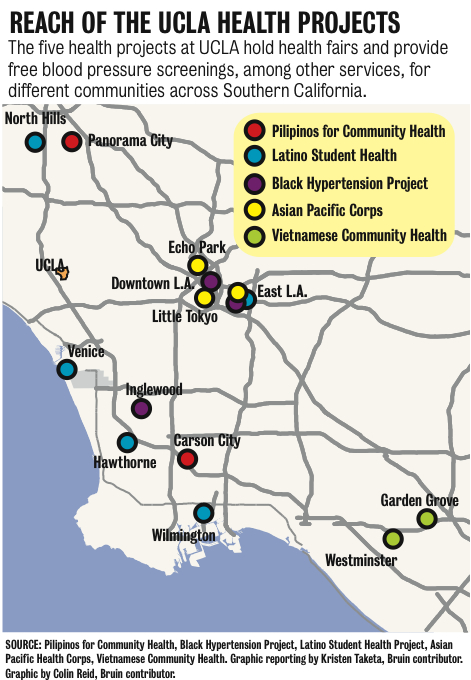Ever since Kevin Uson’s mother discovered she had high blood pressure during his freshman year of college, they both started eating healthier foods and ran around a nearby track together three times each week.
Eventually, her blood pressure came down to a healthier level. Her success inspired Uson, now a fourth-year physiological sciences student, to help others achieve the same results through the UCLA student group Pilipinos for Community Health. He spends his weekends giving free blood pressure screenings to educate communities about how to help prevent and treat the condition, a risk factor for heart attacks and strokes.
“If I can make such a big impact in my own family, imagine what kind of impact we can make in all the communities that we serve,” Uson said. “I just want to give back in any way that I can.”
Uson and other volunteers from five UCLA student health groups that provide blood pressure screenings to disadvantaged communities are now coming together for the first time to train their members and develop guidelines for how to conduct screenings.
The groups ““ Pilipinos for Community Health, the Black Hypertension Project, Vietnamese Community Health, the Latino Student Health Project and Asian Pacific Health Corps ““ are also partnering with the American Heart Association, which will provide them with free training.
“It’s a great gratification and satisfaction that the American Heart Association was willing to work with us,” Uson said. “It really feels like a validation for the work that our health projects do.”
This newfound unity among the five health projects was prompted by a moment of crisis when the only blood pressure screening certification class in Los Angeles, offered by the American Red Cross, was canceled without prior notice.
The American Red Cross could not be reached for comment as to why the class was canceled.
Blood pressure screening is one of the few health services many student volunteers can provide if they have proper training, said Jason Cheung, who has been the health fair director for the Asian Pacific Health Corps for two years.
Though the five groups cater to different ethnic communities, they operate in similar ways.
The organizations regularly visit various sites, from supermarkets to shopping malls, and hold health fairs in the Los Angeles area, the project leaders said.
At these sites, the students give free blood pressure and body mass index screenings to disadvantaged communities. If recipients have higher than normal blood pressure or body mass index, the student volunteers advise them to see a doctor and explain how they can eat a healthier diet and exercise, Uson said.
Within the student groups, each volunteer must be certified on how to do blood pressure screenings before they can visit a site to avoid liability issues and to ensure services are provided correctly, said Belem Lamas, chair of the UCLA Student Risk Education Committee, which helps students and groups minimize risk of liability in their activities.
After hearing the certification classes were canceled, Uson, co-executive director of Pilipinos for Community Health, gathered the leaders of the five groups so they could find a new organization to teach the classes together.
“I realized (finding a new class) was something I could not do by myself,” Uson said. “This was bigger than me.”
After nearly two months of inquiring into various organizations and entities, the groups received word at the end of July that the American Heart Association was willing to provide a training class for the groups for free.
“Hypertension is one of our huge focus areas,” said Sang-Mi Oh, vice president of health equity at the American Heart Association. “We want to be able to help anyone who wants to be educated and have a great understanding of it.”
The Student Risk Education Committee is helping the student group leaders finalize an agreement with the American Heart Association where the students would receive blood pressure screening training and certification for free, as opposed to the American Red Cross classes, which cost $55 per person to certify.
In exchange, the students can volunteer with the organization’s various events or through internships and will provide the association with general data they collect of how many people have high blood pressure, Oh said. The data is useful because it provides the association with background information on who has high blood pressure and how many people are at risk, she added.
“It’s a win-win situation,” Lamas said.
In addition to bringing back the certification classes, the five health projects collaborated this summer to write a curriculum on how to perform blood pressure screenings, tailored to disadvantaged communities.
The curriculum includes tips on how to maintain equipment and scripts of what to say to individuals at the health sites ““ such as how to notify the recipients they have high blood pressure without scaring them, something the volunteers were not taught in the old training class, Uson said.
The creation of the curriculum and the success of finding a certification class together signifies a newfound team effort on the part of the five student groups, Cheung said.
“Even though we do the same thing, we don’t really get together and work towards a common goal,” he said. “This is the one time I see that (collaboration).”
